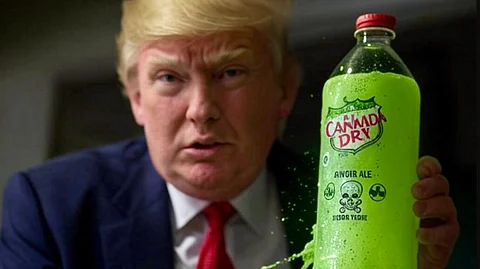

It’s a Canadian legacy with American ownership.
Adding to a homegrown identity crisis in the midst of the US tariff calamity, it turns out one of the country’s most recognized brands — Canada Dry — isn’t as Canadian as its name suggests.
The iconic ginger ale, a household name across the country and a best-selling mixer worldwide, is actually owned by American beverage giant Keurig Dr Pepper.
Which is to say, it won’t be included in the list of products facing 25% tariffs under US president Donald Trump’s trade war. However, it may actually be subject to retaliatory duties from the Liberal government in Ottawa.
The revelation that Canada Dry isn’t Canadian has sparked debate among patriots who are making a conscious effort to buy local products at stores.
A survey commissioned by KPMG found that 90% of Canadians want to buy local products but are having a hard time determining what is actually homegrown from the product label.
“I was always conscientious about Canadian products but now I’m going to be laser-focused on it especially at the grocery store,” a Yahoo Canada reader said.
The irony is that Canada Dry is actually the subject of a class action lawsuit filed in November, 2024 in California for false labelling — because it doesn’t actually contain real ginger, not its point of origin.
The lawsuit alleges that companies are required disclose artificial flavourings under state and federal laws if “the food contains any artificial flavour which simulates, resembles or reinforces the characterizing flavour.”
Therefore, the claim says, the beverages have been misbranded and are illegal to sell in the US. But not because it claims to be Canadian.
Canada Dry was founded in Toronto in 1904 by John J. McLaughlin, a Toronto pharmacist and chemist who created the drink as a smoother alternative to syrupy ginger ales. By 1907, Canada Dry was appointed to the Viceregal Household of the Governor General of Canada, cementing its status as a premium beverage.
During Prohibition in the 1920s, Canada Dry soared in popularity in the US as a mixer that helped mask the harsh taste of bootleg liquor. It became widely known as the “champagne of soda,” expanding globally throughout the 1930s.
Despite its patriotic name, Canada Dry is manufactured in numerous countries, including the US, Mexico, Panama, Chile, Japan, Turkey and several European and Middle Eastern nations.
In many areas of the world the term ‘Canada Dry’ has become synonymous with ginger ale in general.
Over the decades, ownership of the brand changed hands multiple times, moving from Canadian roots to American corporate control. In 2008, it became part of Keurig Dr Pepper, headquartered in Burlington, Massachusetts.
Prior to being bought by Dr Pepper, it was owned by Cadbury which is based in the UK.
However its Canadian subsidiary, Canada Dry MOTT’s Inc. — which makes Clamato juice — is indeed based in Mississauga.
Confused? Don’t be.
While Canada Dry maintains a strong presence in Canadian grocery stores and bars — and is produced and distributed by local bottlers — the profits ultimately flow toAmerican shareholders.
Nonetheless, Canada Dry remains a major player in the $5.2 billion ginger ale market with 88% brand recognition among soft drink consumers in the US. And not just in North America. It has almost a third of the ginger ale market in countries like Germany.
Market research indicates ginger ale consumption is on the rise, with the global market expected to hit USD$8.12 billion by 2030. Health-conscious consumers are increasingly drawn to ginger ale’s perceived benefits, such as aiding digestion and soothing sore throats.
While it remains a nostalgic and beloved name, its foreign ownership challenges the assumption that buying Canada Dry supports the local economy. It also serves as a reminder to check the labels — not just the brand name — when shopping for homegrown goods.
Caveat emptor.
